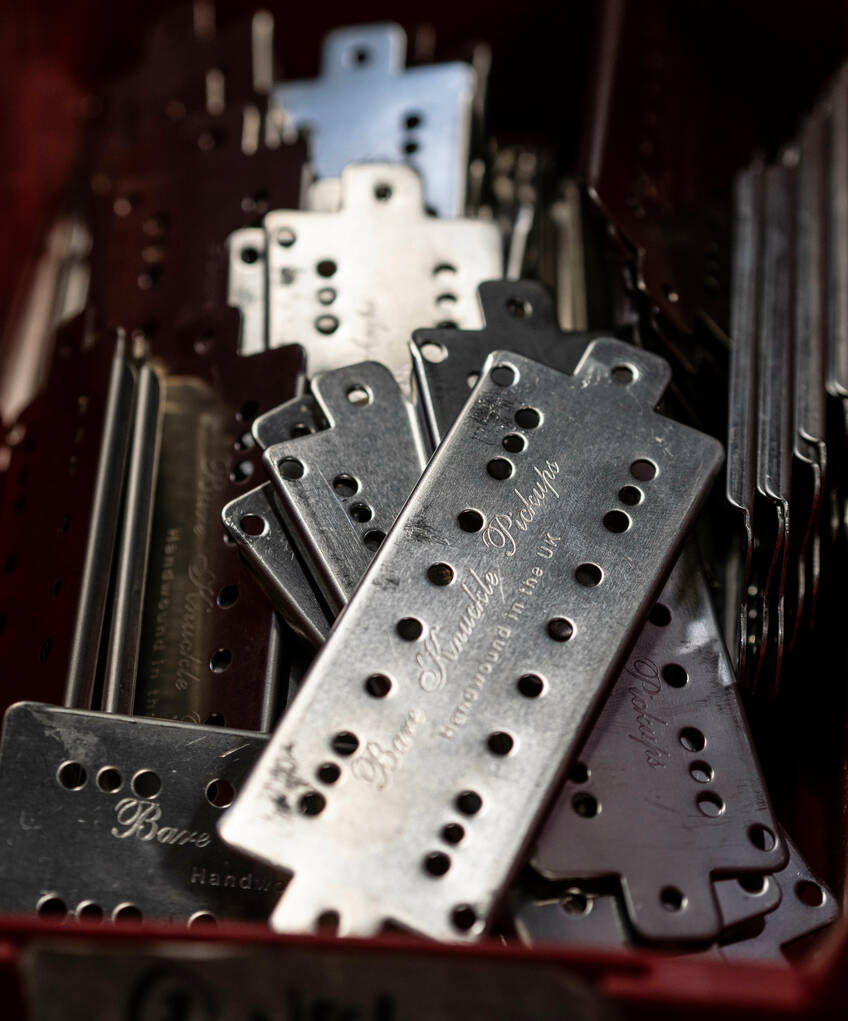What Goes Into A Bare Knuckle? - Covers and baseplates
15th June 2023
How metalwork affects your tone


In any electromagnetic pickup, the metallic objects which sit within its magnetic field will all be playing a part in affecting tone. The principal ways in which this is manifested are through changes to the overall inductance of the pickup, changes to the magnetic field shape and changes in the prominence of eddy currents within the pickup.
In very simple terms, increasing metal mass in a pickup will increase inductance, shifting the overall frequency range downward and lowering the resonant peak of the pickup (the frequency band of the pickup where it is most efficient). If that metal can also be magnetised, this can extend the magnetic field outwards (especially in the case of metal on the outer edges of the pickup, such as covers and baseplates). Eddy currents can be formed in metallic components that are particularly highly conductive and are essentially formed when the pickup drives an AC signal through the metalwork, rather than just through the pickup's coil. This can create minor secondary magnetic fields which conflict with the main magnet and sap power away from the output of the pickup. While these individual effects are different, they will all contribute to a loss of high frequency detail and presence, so, in order to get a great, lively response from a pickup, they need to be accounted for in the design and material choices.
Choosing the right materials


To mitigate and control these effects, what is required is a material for covers and baseplates which is low-mass, non-magnetic and not an especially efficient conductor.
Nickel silver is a great alloy for this and has been used for decades in the finest humbucker builds, due to its ability to form a strong component from relatively thin stock, low magnetism and comparably low conductivity (compared to copper or aluminium, for example). This results in a particularly "transparent" component which has very little effect on colouring or attenuating high frequency content in the pickup's output. We use German nickel silver stock for all of our humbucker covers and baseplates.
Alternatives that are sometimes used in guitar pickups can be brass type alloys, which tend to suffer more with eddy currents, or basic steel alloys, which are strong, but have a higher mass, strongly affecting inductance and are also often easily magnetised, affecting the magnetic field. When building pickups using these cheaper, but tonally compromised materials, it's often necessary to radically adjust the voicing of the coils to acount for this, resulting in a dull, hollow-sounding tone.
Special applications


There are, however, some circumstances where we might deliberately use materials which affect the tone, to achieve a certain feel with specific pickup designs:
Telecaster pickups have traditionally been fitted with a plated steel baseplate on the bridge position pickup since the very beginning. This design extends the magnetic field in order to increase bass response, as well as using the increase in inductance to attenuate the high end a little, resulting in a fuller, broader tone from what would otherwise be a very bright and piercing pickup. We translate that design over to our Strat singlecoil range too, offering optional zinc-plated steel baseplates on many of our models. This is available for all positions, but is more often than not selected just for the bridge pickup, being the brightest of the set.
We do, also, occasionally use alternative materials purely to be accurate to original designs. Our Chrome plated Tele neck covers, for example, are manufactured using a deep-drawn brass blank, rather than nickel silver, to maintain accuracy with original vintage examples. We build all other finishes using our normal nickel silver construction, but the chrome option is made to match those original specs, so will produce a slightly rounder response in the highs.

